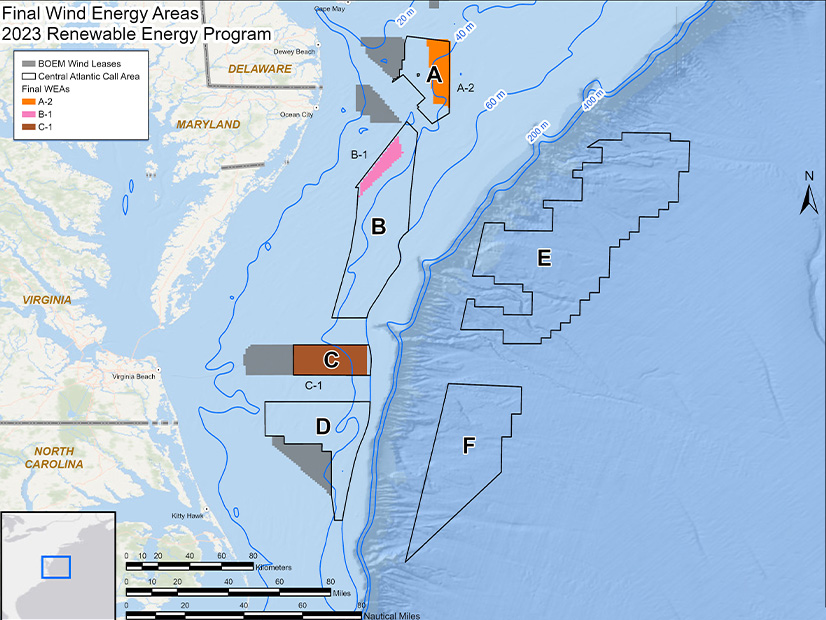
Federal regulators are moving forward with three new wind energy areas off the Delaware, Maryland and Virginia coasts.
The WEAs total about 357,000 acres, 23 to 35 nautical miles off the DelMarVa peninsula, from the Delaware Bay to the Chesapeake Bay. If fully developed, they are believed to hold the potential for 4 GW to 8 GW of production capacity.
The Bureau of Ocean Energy Management’s announcement Monday of the three Central Atlantic WEA boundaries and publication Tuesday of a notice of intent to conduct an environmental analysis is a step forward, but only an early step.
BOEM is committed to holding a Central Atlantic lease auction by August 2024, but the process would continue for years before any construction can start.
And one of the three WEAs may never go to auction: BOEM is still doing an in-depth review with NASA and the Department of Defense to see if wind energy in the WEA designated B-1 could co-exist with the extensive space and military activities nearby.
BOEM said if WEA B-1 does go to auction, mitigation measures would be identified first, so bidders would be aware of steps they would need to take there.
Publication of the notice of intent (Docket BOEM-2023-0034) in the Federal Register on Tuesday launched a one-month public comment period.
BOEM said in a news release that extensive stakeholder and public input already has been incorporated into the planning process.
In April 2022, the Department of the Interior announced a call area of 3.9 million acres off the Central Atlantic Coast.
In November 2022, BOEM narrowed that down to eight draft WEAs covering 1.7 million acres from Delaware to North Carolina.
The three finalized this week are:
-
- WEA A-2 — 102,000 acres, 26 nautical miles from Delaware Bay;
- WEA B-1 — 78,000 acres, 23.5 nautical miles southeast of Ocean City, Md.;
- WEA C-1 — 177,000 acres, 35 nautical miles from the mouth of Chesapeake Bay.
In its announcement, BOEM said these three WEAs encompass relatively shallow waters. It said it might identify additional WEAs for leasing in deepwater areas along the Central Atlantic Coast in the future, after further study.
BOEM told NetZero Insider on Tuesday the other five draft WEAs initially identified in November could be part of such a future lease auction.
Offshore wind development along the Central Atlantic Coast is in potential conflict with a constituency much more influential than the fishermen and beachfront property owners who oppose the wind turbines almost everywhere they are proposed.
The south end of the Chesapeake Bay is densely packed with military facilities, including the world’s largest naval base and airfields for multiple squadrons of supersonic fighter jets.
To the north, NASA has its Wallops Island launch facility. To the south, the Navy has its Dare County bombing and gunnery range.
Offshore wind skeptics and opponents pounced on a Bloomberg report in April that DoD had flagged large swaths of the Atlantic coast from Delaware to North Carolina as “highly problematic” for offshore wind development.
This friction between military planners and one of their commander-in-chief’s signature clean-energy initiatives developed outside of the public eye.
But a DoD spokesperson later confirmed in comments to Gizmodo the agency in fact had identified “compatibility challenges” between military training and offshore wind in this region.
In the environmental impact statements it has prepared for offshore wind farms farther north on the Atlantic Coast, BOEM has predicted a significant negative effect on U.S. Coast Guard search and rescue operations — the towering height of the turbines and the expansive sweep of their rotors would limit flight operations below 1,000 feet and complicate surface operations.


